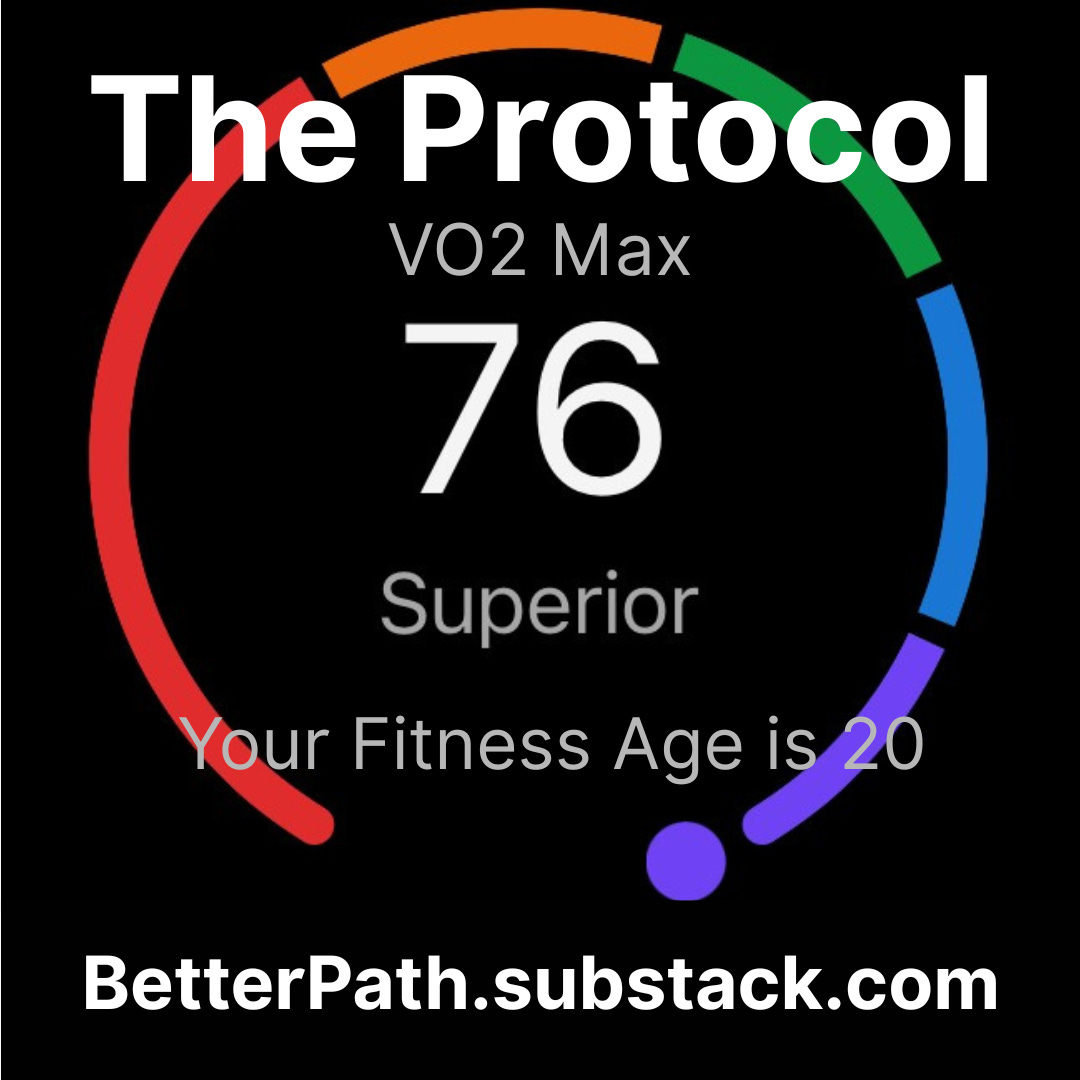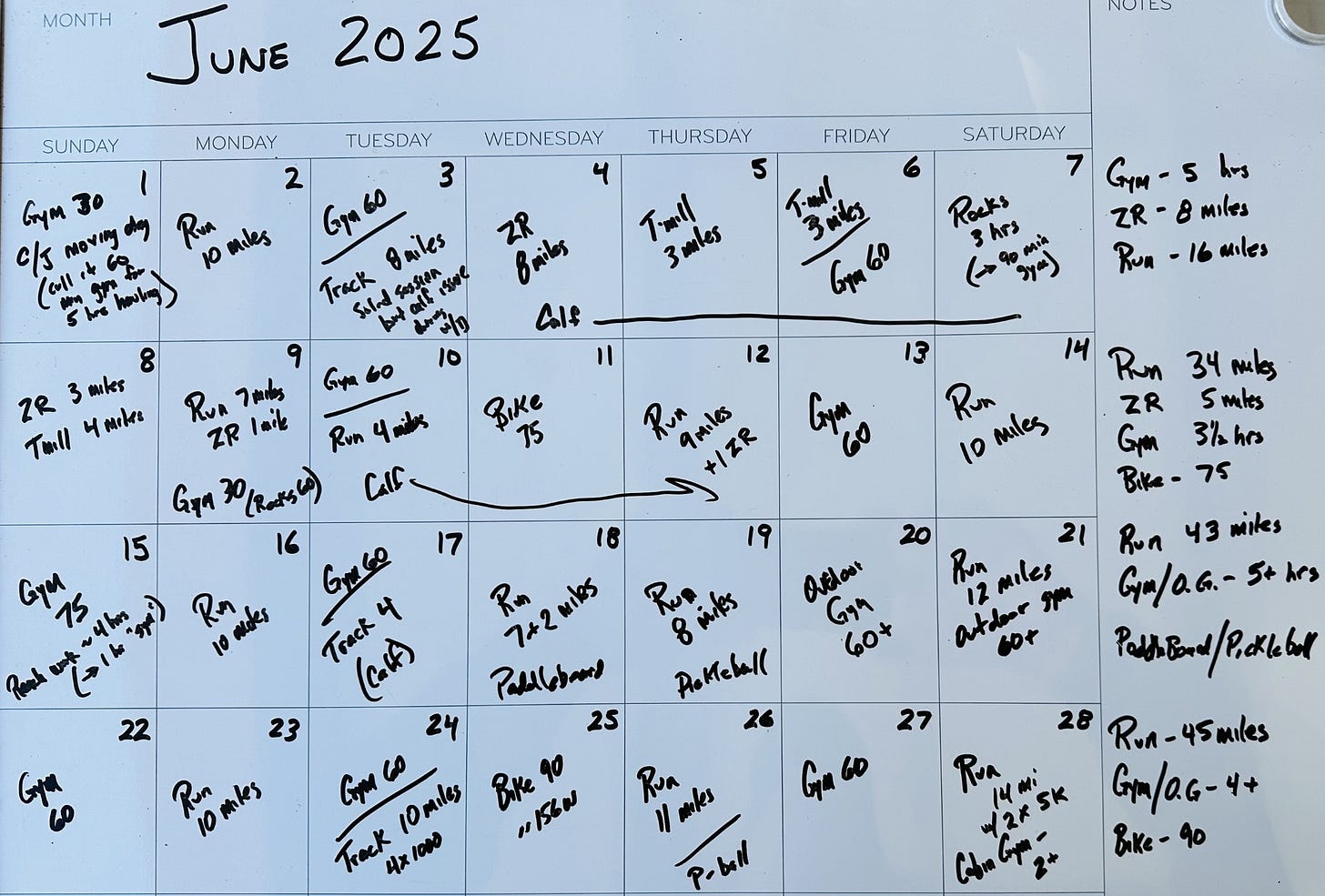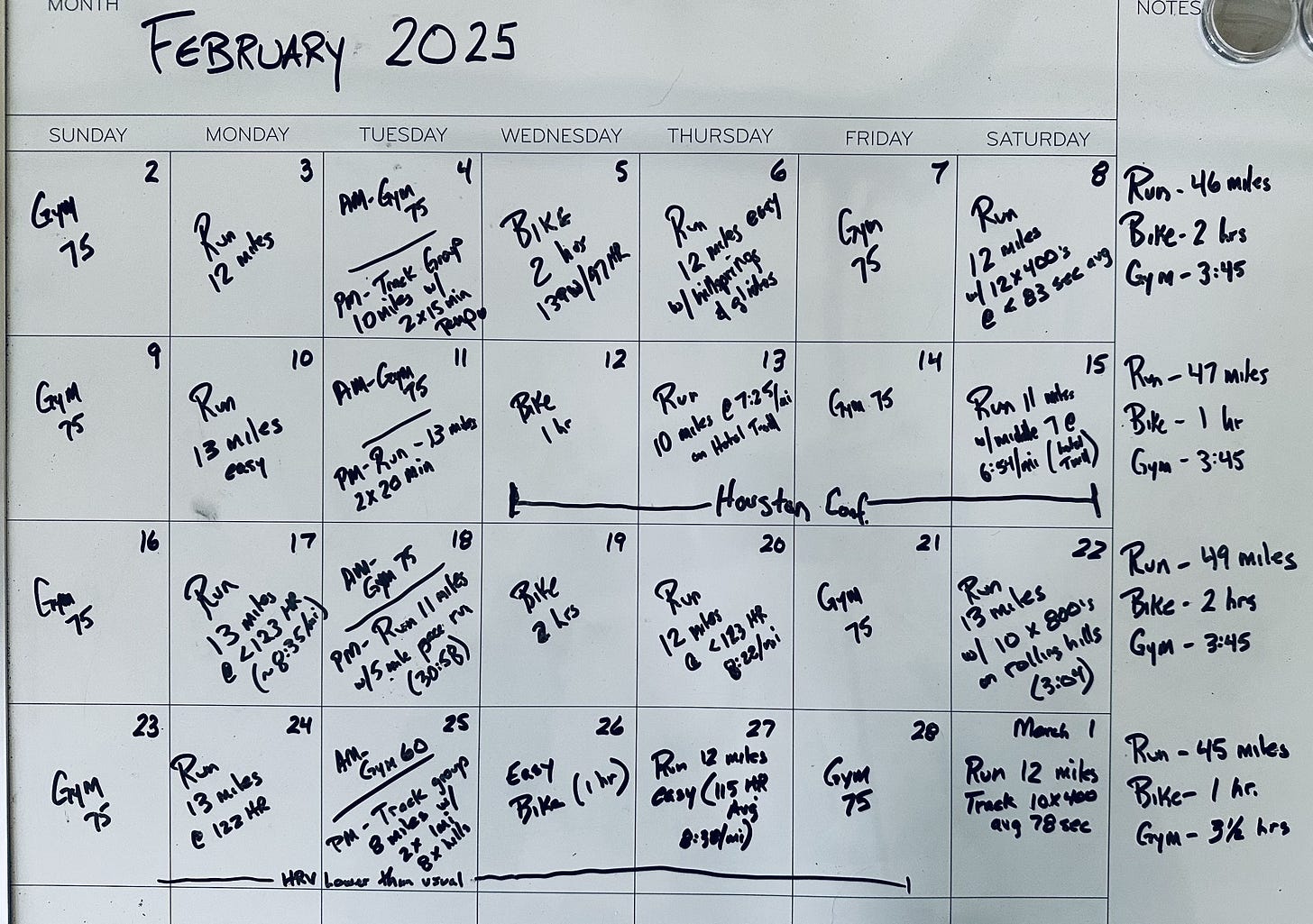The Protocol
The secret to life? There isn't one - in spite of what the influencers keep telling (selling) you.
The image above came from my GarminConnect last week. No - it’s not accurate (I’m likely in ballpark of 60). There aren’t many (if any!) 59-year-olds in the world with a VO2 Max of 76 (average is 23-28). Also, based on my fatigue after a fun day with our granddaughters, my “age” is definitely not 20 :-). Yet when I jokingly posted this on X, referencing longevity guru Bryan Johnson’s claim that his data shows he’s the same “biological age” as his son (he’s 47, and his metrics said 18), it was viewed by 24,000 and received more comments than anything I’ve ever posted (I’m small potatoes on X, but still!). Many of the comments were versions of “what are you doing to have that readout at age 59??” In other words - what’s the protocol?
Fair question. I promised to follow up that tongue-in-cheek post with some details about my fitness and fueling routines, which I’ll include below. However, the bigger point is this: trade the obsession with “protocols” for a personalized approach to fully living. Yes - something I mention below may spark an idea for you, but how you live it out will be based on you. Ditch the protocols of others and lean into the path leading to the best version of you.
“Those devoid of imagination live in a sort of trivial compendium of experiences about how things turn out, what things are possible, what usually happens. In this way, they lose themselves” (Soren Kierkegaard)
Writing in the mid-1800’s, Kierkegaard just as easily been talking about today’s trend of blindly following charismatic influencers and their magical threads of insight (aka, protocols). The alternative? Consider the guidance. Test it in the evidence-based fires. Then shape an individualized path designed to fit our own needs, goals, history, and (especially) personal vision. Trivial compendium of experiences about what usually happens? Or a powerful, imaginative life of service and significance? The choice is up to us.
Now onto those protocols. Just kidding. Here are a few of my routines that may spark an idea for you that may be beneficial IF applied in a way that fits your unique life…
Fitness - Goals drive specifics here, but over the past year, I’ve automated the Beatles strategy -“8 Days a Week”. Run 40-50 miles Mon/Tues PM/Thurs/Sat (occasionally bumping that to 50-60 miles by adding a Sunday run)… Gym 3+ hrs Sun/Tues/Fri… Ride 20-30 miles Wednesday. Two runs are super easy (HR 115-123) with our Aussie pup, Sky. Then group track night (Tues) and a longer tempo/pace run on Saturday (e.g., 2 x 5K inside 14 miler). That’s it. No “motivation” or “discipline” needed. Completely automated. It’s Monday? Let’s run! Friday? Gym time! I never wake up pondering what to do - it’s already been automated.
There are exceptions. If I’m working through an injury, I may trade out a run for the Zero Runner, more cycling or a rucking session. However, the rhythm remains in place. An injury isn’t a ticket to sit on the couch - it’s a challenge to find a viable alternative. While prioritized (for example, I enjoyed 9 runs during our 11 days in Italy back in May), I’m also flexible about tweaking based on travel or family events. During the summer, there’s also plenty of work to be done on the 35 acres around our home, so I may spend some of my gym time (or add to it) working the land or similar outdoor activities for variety. Here’s a glance at last month’s overview. I was nursing a calf injury most of the month so you can see a good example of reduced running (both mileage and the intensity) being replaced by alternatives. An injury doesn’t send me to the couch - it sends me to an alternative activity. In addition to keeping the rhythm consistent, the alternatives also allow for a rapid return to the desired 40-50 mile baseline once the injury resolves.
Here’s an example of a more typical month (February) that doesn’t involve the replacement activities but does include adjustments for a conference in Houston and a lower intensity week when my morning HRV was off:
Fueling - This is also generally automated from 5 AM to 6 PM. No discipline. No motivation. It’s just become part of who I am, making it simple to live out consistently. A cup of black coffee early while reading/journaling. Typically 1 more cup before 10 AM. A mix of protein/creatine/greens for breakfast. If high running mileage and needing additional calories, I’ll have a bowl of granola with some fruit. Lunch is a giant, nutrient-dense salad with a protein source (chicken, salmon, tuna). Afternoon snack is a square or two of 90% dark chocolate and some almonds. Dinner with Suzanna varies but generally veggies, protein source, beans and quinoa/potato. I ebb and flow regarding wine (more flowing than ebbing while we were in Italy), but average two glasses/week with dinner.
Other considerations of potential interest
Sleep doesn’t always come easy, but it is a priority and I’m fortunate to consistently enjoy 7 1/2 - 8 hours/night on a relatively consistent schedule of 9:30 PM -5ish AM. I’m also fortunate to have some control over my schedule (we’ve run Catalyst Coaching out of our home since our national launch in 2007). So, if the night was lacking, I’ll add a nap to the afternoon schedule. I took a deeper dive into sleep strategies here.
I track my morning HRV & RHR using HRV4Training app (no relationship to the company). Resting HR generally sits 41-42. If HRV is off, I’ll adjust intensity of training or integrate some additional sleep.
Supplements. I weigh ~150 lbs (68 kg) and target 1.2 - 1.6 g/kg of protein/day. Creatine research of late has been encouraging so I include 10g/day. Otherwise, all supplements are based on an annual deep blood work review with my lifestyle medicine physician. I do use multiple supplements, but ALL of them are based on his recommendations and NEVER based on “something I saw on the internet/social media or heard from a friend.” I cannot emphasize this enough. Please be sure any supplements are based on your personal bloodwork results - not influencers. And no - I’m not going to share current supplements beyond protein/creatine as that would defeat the point of the message! :-)
Medications. I’m fortunate to not require any medications up to this point in my life. I also don’t take any sort of testosterone or utilize any form of PEDs due to my desire to compete (legally) and track natural physiological progress and declines over time without the affect of these variables.
Monitoring effects of aging. Age gets far too much credit for physical declines that it deserves - but let’s not kid ourselves - it obviously is a factor. To monitor this in my own life, I primarily track two things (beyond annual physical and blood work review) annually. The first is a pair of races I’ve done for years. One in the spring and one in the fall. It’s fun - and interesting - to view changes over time on same course. Second, I do this simple physical assessment called the Personal Performance Quotient. Almost anyone can do it without special equipment, training, or cost. Definitely worth checking out, regardless of age.
There you go. The protocols you need to get your VO2 Max up to 76 as you approach age 60. Seriously though - I hope this was helpful - not only in providing an idea or two for your own life, but also a reminder it is YOUR life. The “influencers” don’t know you, your schedule, history, support systems, blood work, stress levels, athletic background, etc. They’re just trying to get clicks! (and sales). The more dramatic, the better. Don’t fall for it.
The secret of life is there ain’t no secret… And you don’t get your money back.
-Faith Hill, The Secret of Life







This is great! Consistency is clearly a hall mark of your "success", meaning your "success" is the culmination of well meaning, consistent intentional effort. There is no luck (other than maybe good parents providing the right genetics ;-)).
Well done.
Thanks for sharing this, Brad!!